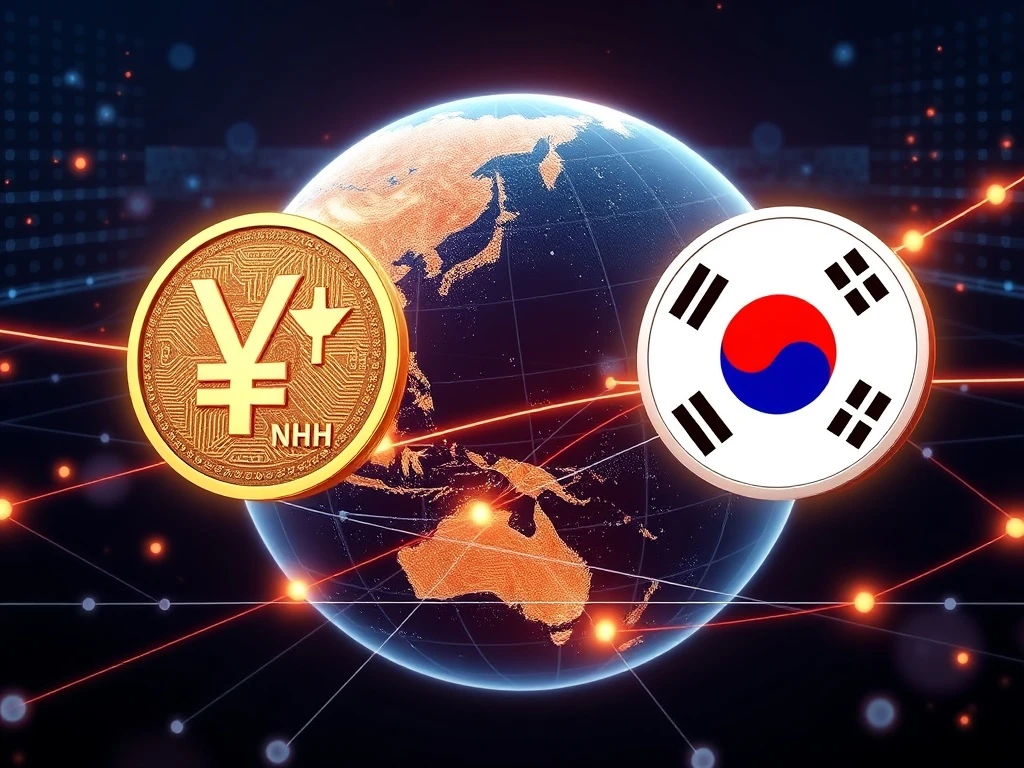Chinese Stablecoin Unlocks Global Payments: The Crucial Race Accelerates

The cryptocurrency world witnessed a significant development this week. The first regulated Chinese stablecoin, AxCNH, made its debut. This event marks a crucial moment in the accelerating global stablecoin race. Governments worldwide are actively exploring and launching their own digital fiat tokens. They aim to remain competitive against established dollar-pegged stablecoins. This shift signals a new era for international finance and digital currency adoption.
The Global Stablecoin Race Heats Up with New Entrants
The competition in the digital asset space intensifies. This week, two new stablecoins launched. First, a regulated stablecoin tied to the international version of the Chinese yuan (CNH) emerged. This token, called AxCNH, targets foreign exchange markets. Second, a South Korean won (KRW) stablecoin also debuted. Financial technology company AnchorX unveiled its AxCNH yuan-pegged stablecoin on Wednesday. This launch occurred at the Belt and Road Summit in Hong Kong. The move follows a recent regulatory shift in China. China now embraces stablecoins for international markets. BDACS, a digital asset infrastructure company, simultaneously announced the launch of KRW1. This Korean won-pegged stablecoin launched on Thursday.
Both KRW1 and AxCNH are overcollateralized stablecoins. This means they are fully backed 1:1 by fiat currency deposits. They also use government debt instruments. A custodian holds these assets. This structure ensures stability and trust. The AxCNH stablecoin specifically aims to facilitate cross-border transactions. It supports countries involved in the Belt and Road initiative. This massive infrastructure project connects China to the Middle East and Europe. It also establishes vital maritime trade routes with other regions. Therefore, these new stablecoins hold significant strategic importance.
Unlocking Cross-Border Payments with the CNH Stablecoin
The traditional financial system often faces significant challenges. It operates slowly and requires robust infrastructure. This infrastructure may not exist in many developing areas. Furthermore, certain jurisdictions implement currency controls. These controls can significantly hamper demand for fiat currencies. Placing fiat currencies on blockchain rails offers a powerful solution. Blockchain networks operate 24/7. They also feature near-instant, cross-border settlement. This dramatically increases international demand. It makes fiat more accessible to the average person. Consequently, this increased accessibility can help offset price increases caused by currency inflation.
The introduction of the CNH stablecoin, AxCNH, exemplifies this trend. It streamlines transactions. It also reduces costs associated with traditional foreign exchange. This digital yuan variant could revolutionize trade within the Belt and Road network. Imagine businesses conducting instant settlements across continents. This capability fosters greater economic integration. Moreover, it strengthens China’s financial influence globally. The convenience and efficiency of these digital tokens are undeniable. They represent a significant leap forward in financial technology. This innovation promises to reshape how international trade functions.
Stablecoins, Inflation, and Global Government Debt
Stablecoins have gained immense geo-strategic importance. Sovereign governments are now rushing to place their fiat currencies on digital rails. This strategy aims to increase international demand for their currencies. They hope to offset inflationary effects from extensive currency printing. The interplay between stablecoins, fiat currencies, inflation, and government debt is complex. The US government’s national debt, for instance, recently crossed the $37 trillion mark. This reflects record-high government debt levels worldwide.
Currency inflation typically results in price increases. This occurs because the demand for the currency does not match the additional supply created through money printing. Overcollateralized stablecoin issuers, such as Tether and Circle, offer a unique solution. They purchase government debt instruments and cash assets. These assets then back their digital fiat tokens. Subsequently, they make these tokens accessible globally. Anyone with a mobile phone and a crypto wallet can use them. Essentially, these companies provide an avenue for individuals worldwide to become indirect bond buyers. This boosts the market for those assets. It also lowers yields on state-issued debt. Ultimately, this reduces the government’s debt-service burden.
The Future of Fiat: Digital Currencies and the Chinese Stablecoin
Tether has emerged as one of the largest US Treasury bill holders globally. It now surpasses several developed countries, including Canada, Norway, and Germany. This highlights the significant financial power stablecoin issuers wield. Anton Kobyakov, an advisor to Russian President Vladimir Putin, recently commented on this trend. He suggested the US government is attempting to offset its $37 trillion debt. It uses stablecoins and gold to boost confidence in the declining US dollar. This perspective underscores the geopolitical implications of digital currencies. The global stablecoin race is not just about technology; it’s about economic sovereignty.
The debut of the Chinese stablecoin AxCNH represents a pivotal moment. It signals China’s strategic move to digitize its currency for international use. This initiative aligns with broader efforts to modernize financial infrastructure. As more nations explore their own digital currencies, the landscape of global finance will continue to evolve. This ongoing transformation will impact trade, investment, and geopolitical power dynamics. Consequently, understanding these developments becomes crucial for anyone in the crypto space. The future of money is undeniably digital, and the race for dominance has just begun.







